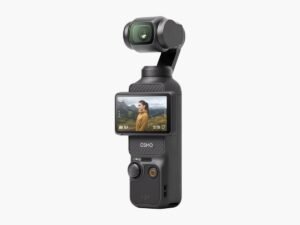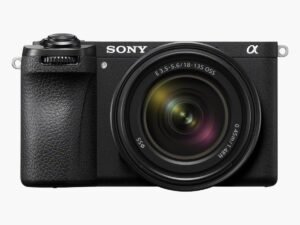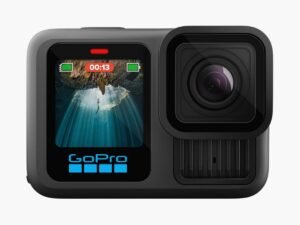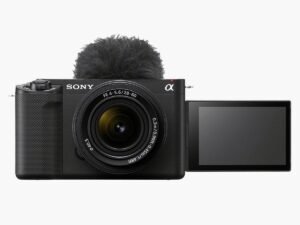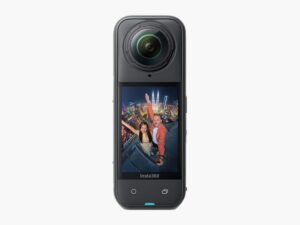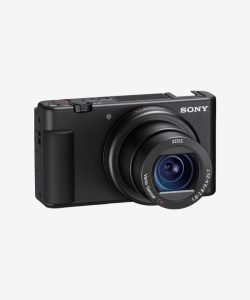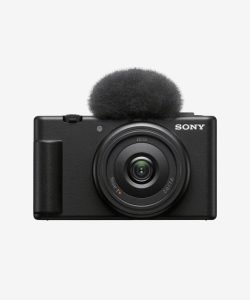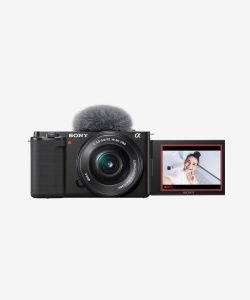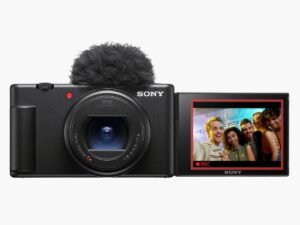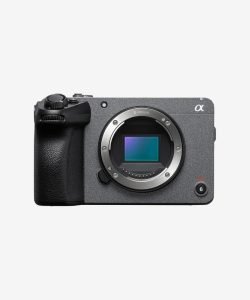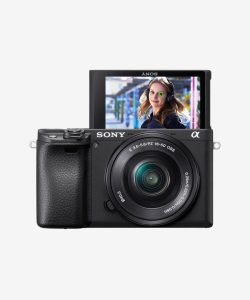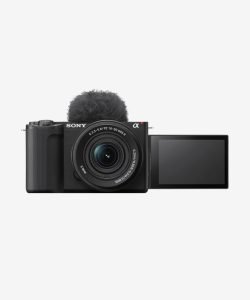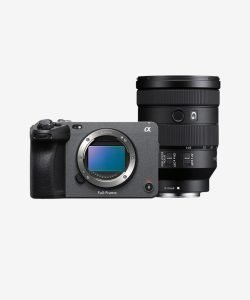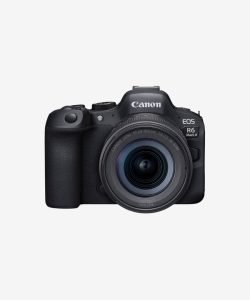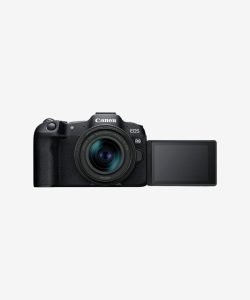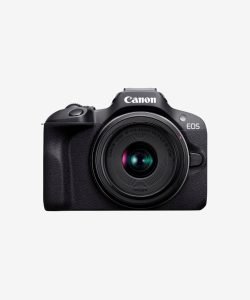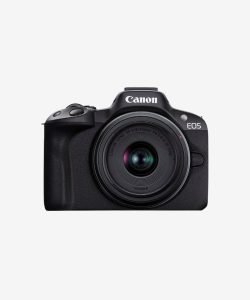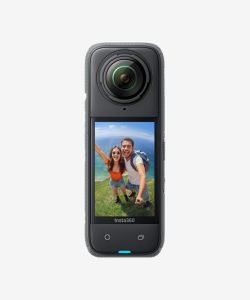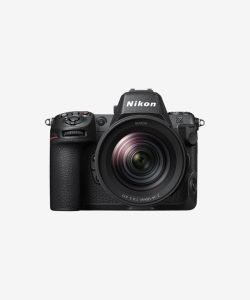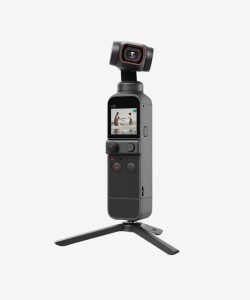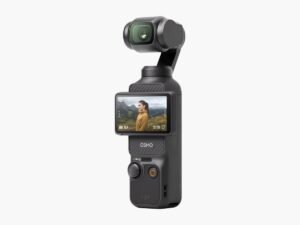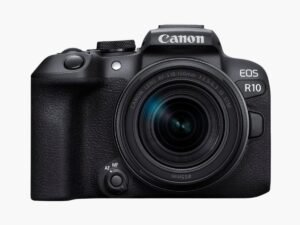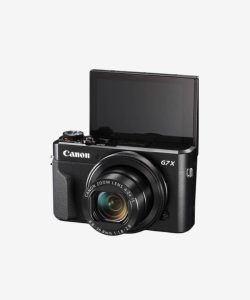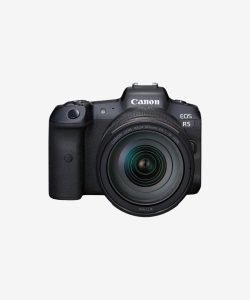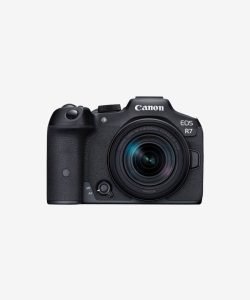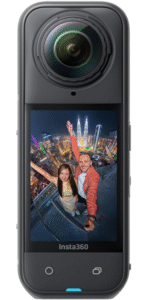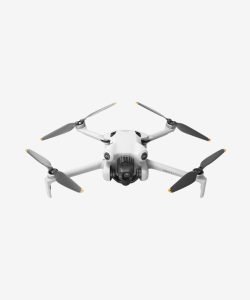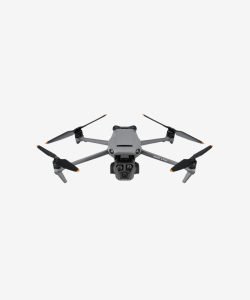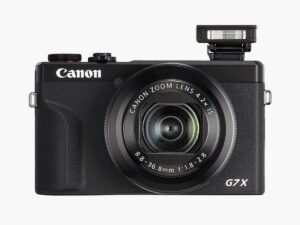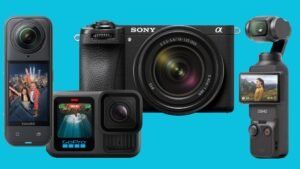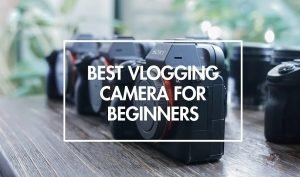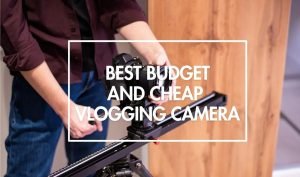The Sony Alpha ZV-E1 is the best 4k camera of 2025. Its a full-frame camera…
Top 5 Vlogging Cameras: Expert Tips, In-Depth Testing and Buying Guide To Choose the Best Vlogging Camera
Looking for the best vlogging camera? There are many different types of cameras for vlogging available, but the best one is the one that best suits your needs. Make YouTube videos, TikTok and professional quality vlogs by picking the one of the best vlogging cameras. These are best options from SONY, CANON, and DJI for the money.
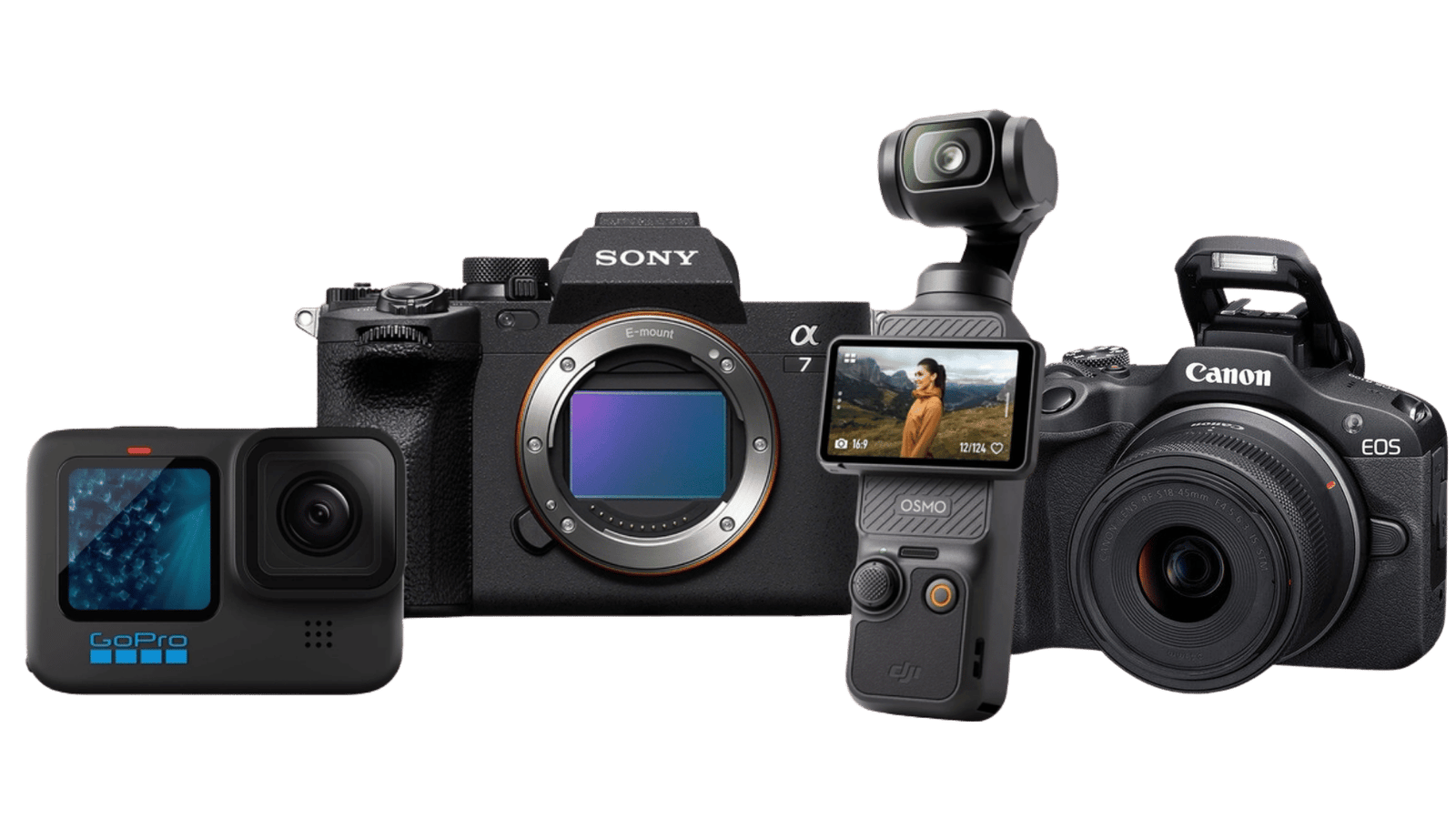
QUICK LIST
- Best Overall: DJI Osmo Pocket 3
- Best Budget: GoPro Hero 13 Black
- Best Sony: Sony Alpha 6700
- Best Canon: Canon EOS R50 V
- Best Beginner: Insta360 X5
Types of Cameras for Vlogging
Choosing the right vlogging camera means understanding what you need for your content creation. Camera selection depends on your unique style and where you shoot, unlike other tech purchases. Your choice of video content creation tool can substantially affect your budget and production quality. Understanding camera options becomes crucial here.
Mirrorless Cameras
Mirrorless cameras are where things get interesting. They’re the sweet spot for serious vloggers who want flexibility. You get three big wins: interchangeable lenses for creative freedom, larger sensors for better image quality, and compatibility with tons of accessories. The downside? Your wallet will feel it. We’re talking $900 for an entry-level APS-C kit or up to $2,300 if you want full-frame capabilities.
Action Cameras
Action cameras are the tough guys of the bunch. Waterproof, shockproof, dustproof—they’re built to take a beating, which makes them perfect for adventure vloggers. They’re also easier on the budget, starting around $100. But there’s a catch: those smaller sensors mean you’re trading image quality for durability.
360-degree Cameras
360-degree cameras are dedicated cameras that are designed to take 360-degree photos and videos. They’re a relatively new type of camera that is designed to be used with VR headsets, and they’re specifically designed to create high-quality 360-degree vlogs. 360-degree cameras are compact, durable, and easy to use, and they’re an excellent choice for vloggers who want to create high-quality 360-degree vlogs.
Point-To-Shoot Cameras
Compact point-to-shoot cameras deliver serious bang for your buck if you’re budget-conscious. You get everything you need straight out of the box without worrying about additional lens expenses. Take something like the Canon PowerShot V1—it packs a larger sensor than your typical compact, giving you superior image quality while staying relatively affordable compared to the professional options.
Vlogging Cameras
The following cameras have been selected as the top 5 best cameras for vlogging based on a combination of popularity, price, and features. They’re suitable for a wide range of vloggers and all have something to offer for any vlogging style. If you’re still unsure about which camera would work best for you, keep reading this buying guide to discover what key features to look for when buying a vlogging camera.
1. DJI Osmo Pocket 3
The DJI Osmo Pocket 3 is a 4k vlogging camera due to its high end performance, pocket size design and mid-range price point. It has a 1-inch sensor, advanced autofocus capabilities, and a latest gimbal system, making it an excellent choice for content creators on the go.You can easily carry the DJI Osmo Pocket 3 wherever you go, thanks to its compact size. It fits right in your pocket and is ready to start making 4k videos right away.
One of the standout features of the Pocket 3 is its advanced autofocus system. The camera utilizes DJI’s renowned ActiveTrack 3.0 technology, ensuring that your subject remains in sharp focus, even when moving around the frame. This is particularly useful for vloggers who often need to film themselves while on the go. It also has four microphones with directional audio and sound tracking, providing better audio quality compared to its predecessor. You can adjust the microphone’s directionality to prioritize sound from the front, back, or all around the camera, depending on your shooting situation.
DJI has designed the Pocket 3 for vlogging. It includes AI Editor 3.0 for automatic editing and effects. Timelapse, Motionlapse, and Hyperlapse modes for advanced use. Story mode with customizable templates and live streaming support for social media platforms.
2. Sony ZV-1 II
The ZV-1 II is the latest sony camera for vlogging with an ultra-wide 18-50mm zoom lens. Whether you’re vlogging wide landscapes or intimate close-ups, this versatile lens has you covered. The large 1.0-type sensor delivers professional results even in low-light conditions, making it perfect for vlogging in various settings. Its vari-angle fully articulating touchscreen makes it easy to compose shots from any angle, ideal for vlogging and selfies. Withadvanced real-time eye AF and tracking, the ZV-1 II maintain sharp and clear focus on your subject. It offers 4K video recording and supportive features like background defocus and high-speed shooting. Its combination of high-quality image quality, 4k resolution video making, advanced autofocus, and compact design make it a top choice for vloggers looking for a compact vlogging camera.
3. Sony ZV-E10
The Sony Alpha ZV-E10 is a mid-range mirrorless camera designed specifically for vloggers and video content creators. With its 24.2MP sensor, excellent autofocus system, and a range of dedicated vlogging features, the ZV-E10 delivers impressive image quality and performance in a compact package. The ZV-E10 supports both Bluetooth and Wi-Fi, enabling easy pairing with the Sony Imaging Edge Mobile app for remote control and wireless file transfer. It can be connect to wireless microphones, expanding its audio recording range.
Its battery life is quite impressivr, with Sony claiming up to 440 shots per charge or 80 minutes of continuous video recording. The camera supports USB-C charging, ensuring that you can keep shooting even when you’re on the move. Overall, the Sony Alpha ZV-E10 is a feature-packed and user-friendly camera that caters to the needs of vloggers and content creators. Its combination of a large APS-C sensor, advanced video capabilities, and extensive connectivity options make it an excellent choice for anyone looking to elevate the quality of their content.
4. Canon EOS R50
The Canon R50 vlog camera is the best Canon 24.2MP APS-C CMOS sensor camera, which is about three times larger than the 1-inch sensors found in most smartphones. This larger sensor size enables the camera to capture more light, resulting in cleaner, clearer images with well-defined details even in low-light situations. The camera also features a DIGIC X image processor, which powers its advanced autofocus system and enables high-speed continuous shooting at up to 15 fps with the electronic shutter.
One of the standout features of the EOS R50 is its intelligent autofocus system. The camera utilizes Canon’s Dual Pixel CMOS AF II technology, which covers up to 100% of the image frame with 651 AF zones. Its AF points works in tandem with the EOS iTR AF X subject detection and tracking system, which uses deep learning algorithms to recognize and track people, animals (dogs, cats, and birds), and vehicles (cars and motorcycles) with accuracy.
For vloggers and content creators, the EOS R50 offers a range of videography features like 4K/30p video recording without crop, oversampled from 6K for enhanced quality, Full HD/120p slow-motion recording and 10-bit 4:2:2 HDR PQ video output for smooth color gradations. It also offer Movie Digital IS for stabilized handheld footage and Vertical video support with aspect ratio markers for easy social media content creation.
5. Sony ZV-E1
The Sony ZV-E1 is the best sony vlogging camera due to high-end video features and lightweight full-frame body. With its 12-megapixel sensor inherited from the acclaimed A7S III, the ZV-E1 delivers outstanding video quality, low-light performance, and a range of AI-powered features designed to simplify the filming process. It offers 4K video capabilities at up to 60fps without cropping, and enjoy 120fps slow-motion at launch via firmware update. Its AI-powered autofocus and dvanced subject tracking ensures your subjects stay sharp, even when moving or turning away from the camera. Its biggest reason to attract vloggers is its improved image stabilization, thanks to Dynamic Active Steady Shot combines optical and digital stabilization for smooth, gimbal-like footage. Its vlog-friendly features like Auto Framing, Product Showcase, and Breathing Compensation to help video creators.
Is a vlogging camera better than a smartphone camera?
Choosing between vlogging cameras and smartphones isn't a simple decision. Dedicated vlogging cameras come with larger sensors that are no match for smartphones when it comes to dynamic range and low-light performance. Most mid-range cameras produce cleaner footage in dark conditions, while smartphones tend to give grainy or artificial-looking results. Lens options give vlogging cameras another edge. Smartphones come with fixed lenses, but vlogging cameras let you switch between wide-angle lenses for landscapes and prime lenses for crisp close-ups. Content creators can play around with different visual styles thanks to this flexibility.
Are vlogging cameras really worth it?
The cost of vlogging equipment can vary a lot depending on what you want to do. Our research shows that 14 celebrity vloggers who have over 1M subscribers spend between $1300-$1900 on their camera setups. More than 100,000 upcoming content creators with 20K-100K subscribers are looking to upgrade their equipment at different price points. Vlogging cameras are an investment that scales with your growth.
Does every vlogging camera fit every video creator?
Choosing a vlogging camera is a personal decision. No single camera works perfectly for every content creator. Each content style needs specific camera features, which means one creator's ideal camera might not work at all for someone else. Your experience level plays a vital role in picking the right equipment. Most beginners start with smartphones or basic cameras to capture spontaneous, unfiltered moments. Content creators at intermediate levels just need mid-range cameras that work better in low light and give more manual control. Professional vloggers ended up getting high-end gear with swappable lenses and advanced features to create polished content.
Are vlogging cameras good for making YouTube videos?
Your YouTube content style determines the right camera choice. Food vloggers get better results with interchangeable lens cameras that excel at close-ups, while travel content creators prefer compact options with good stabilization. Adventure YouTubers add action cams to capture B-roll footage alongside their main camera. Vlogging cameras designed for YouTube give creators a technical edge. The models that shoot 4K at 60fps (or maybe even 120fps for slow-motion) provide more editing flexibility by a lot. Creators can crop their footage, create multiple angles from one shot, and keep the quality high after editing.
Are vlogging cameras actually good?
Creators often ask if specialized vlogging cameras live up to their marketing claims. Our extensive testing shows they do—these devices are a great way to get advantages that affect your final output. Better image quality stands out as the biggest advantage. Vlogging cameras use larger sensors that capture crisp footage with minimal noise when lighting gets tough. These cameras go beyond simple image capture with their special features. Sharp focus stays locked on subjects through movement thanks to quick and precise autofocus systems with eye and object tracking. The built-in stabilization with gyro data smooths shaky footage without needing a separate gimbal.
TOP 5 VLOGGING CAMERAS 2025
What Are the Key Features of a Good Vlogging Camera
A vlogging camera is only as good as its features. Depending on what you want to vlog, certain features will be more important to you than others. To help you choose the best camera for your vlogging needs, we’ve outlined some of the most important features of a vlogging camera below.
4K Video Recording
Resolution makes a big difference in your videos’ quality and versatility. 4K capability stands out as a feature that will pay off long after you buy your vlogging camera. The leap from standard HD (1080p) to 4K gives you four times the resolution – about 8.3 million pixels compared to just 2.1 million in 1080p footage. This huge boost gives you amazing flexibility while editing. You might not think this matters much for simple vlogs, but the advantages really show up when you edit your footage.
4K footage lets you crop up to 50% of the frame and still keep full HD quality in your final export. This gives you multiple camera angles from just one recording effectively. To name just one example, you can shoot a wide shot that shows both you and your surroundings, then crop in for close-ups during editing without losing any quality.
On top of that, 4K recording gives you plenty of room to grade and correct colors without hurting image quality. The extra resolution helps future-proof your content as 4K displays become more common, so your videos will look great for years.
Frame Rates: 60fps and 120fps for Smooth Motion
Frame rate affects how your footage feels by a lot. Standard 24fps (frames per second) looks cinematic, while 60fps creates smoother motion that works great for action sequences or demonstrations. Higher frame rates let you create dramatic slow-motion footage too. You can slow down 60fps footage 2.5x when played at 24fps, and 120fps footage can go 5x slower without looking choppy.
These higher frame rates give you creative options that would need much more expensive gear otherwise. My tests of newer vlogging cameras show that models with both 4K/60fps and 1080p/120fps hit the sweet spot between quality and versatility.
Storage space might worry you since 4K files are bigger. But memory cards are super cheap now. You can get a 128GB SD card for less than $20, which takes care of what used to be a big hurdle for shooting in 4K.
Autofocus Performance
Eye-detection autofocus technology has become much better over the last several years. This AI-driven feature quickly spots and locks onto eyes—human, dog, or cat—and keeps them in focus as subjects move around the frame. You’ll find this feature helpful when you can’t stand behind the camera, like during first-person videos or selfie-style vlogs.
The system works best with wider apertures (f/2.8 or faster) that create a very shallow depth of field. Traditional focusing methods would need constant adjustments, but eye-tracking does everything on its own. You can spend more time connecting with your audience instead of adjusting camera settings.
New improvements help the system work in tough conditions that used to cause issues—backlit scenes, low light, people wearing glasses, or faces that are partly hidden. Your face stays sharp even in challenging shooting conditions.
Real-Time Subject Tracking
Modern vlogging cameras do more than detect eyes—they excel at live tracking. Touch the screen to pick a subject, and the camera’s autofocus will follow that person or object, whatever they do. This feature helps with walk-and-talk vlogs or demonstration videos where you need to move freely. The camera’s AI technology uses smart algorithms to focus on your subject faster and more accurately than even skilled videographers could do by hand.
High-end models come with special “Presenter Lock” technology that keeps focus on one person even in crowds. Many cameras let you switch between multiple subjects with one button press—perfect for interviews or videos with several people. Smart tracking technology helps you avoid buying extra gear like follow focus systems or hiring camera operators. Independent content creators can save money and still get professional results.
Built-In Stabilization
Your vlogs can lose their professional appeal quickly with shaky footage. The good news is that you don’t need expensive external gimbals anymore thanks to modern stabilization technology. These gimbals cost between $150-300. Camera shake and motion blur can ruin your recordings. You can fix this with image stabilization. Two main types of stabilization exist, each offering unique benefits.
Optical Image Stabilization (OIS), also known as Mechanical Image Stabilization (MIS), works with physical parts inside your camera lens or sensor. The system uses gyroscopes and motion sensors to detect movement and adjust the lens elements or sensor position accordingly. This mechanical system gives better results with bigger camera movements because it stabilizes images before they hit the sensor.
Electronic Image Stabilization (EIS) takes a different approach by using software algorithms. The system crops your image slightly and adjusts it frame-by-frame to fix any shakiness. EIS uses less power than OIS, but image quality might drop a bit due to cropping. Your footstep-induced camera shake becomes much smoother with proper stabilization, making your walking vlogs more watchable. The best cameras come with both systems. This combination improves stabilization by fixing different types of movements.
Flip Screen
A flip screen solves one of the biggest problems vloggers face – not knowing if they’re properly framed. This feature is a great way to get immediate feedback when you’re shooting alone without a camera crew. The vlogging camera market features two main screen types, each with its own advantages. Fully articulated (or swivel) screens connect to your camera’s side and rotate all the way around. You can view yourself from any angle with these screens. They give you complete positioning freedom to face forward, backward, upward, downward, or fold inward to protect the screen.
Tilt screens use a bottom hinge that flips up or down vertically. These screens keep the optical axis steady during panning, which makes them perfect to track moving subjects without disorienting camera movements. They work better for street photography and don’t break as easily. Your shooting style should guide your choice between these designs. Street photographers like tilt screens because they’re less noticeable. Vloggers who film themselves often choose fully articulated displays that can face forward. The fully articulating screen also folds inward to protect the LCD when you’re not using it.
User Interface & Controls
Touch functionality has become common in modern flip screens, which changes how you use your camera. You won’t need to reach for physical buttons with touch controls. Compatible models let you:
- Tap to focus on specific subjects
- Swipe through menu options
- Adjust settings while recording
- Zoom in/out with pinch gestures
A quality flip screen helps you create content instead of fighting with your equipment. You won’t have to deal with the frustration of watching your footage later only to find that you were out of frame or at an unflattering angle. So this small feature can save you money by preventing wasted shoots and reshoots from framing mistakes.
Audio Recording Quality
Today’s vlogging cameras pack specialized audio systems that capture clear narration and minimize background noise. Sony’s ZV series, to name just one example, comes with built-in directional 3-capsule microphones that pick up your voice clearly even in tough conditions. These forward-facing microphones focus on sounds from the front of the camera—right where you’ll be standing. Wind noise creates one of the biggest headaches for outdoor vloggers. A gentle breeze can ruin your audio with annoying rumbles and distortion. Most current models solve this with wind reduction technology and windscreens (nicknamed “tribbles” or “dead cats”) that block air movement across mic elements. This simple add-on stops that overwhelming whoosh sound that ruins outdoor shots.
Battery Life
A good vlogging camera should record for at least 70-90 minutes continuously. This gives you enough time to shoot without watching battery levels constantly. Different camera models show huge variations in battery performance. Entry-level cameras might only record 4K for 45 minutes, while high-end models can shoot for more than two hours on one charge. Your camera’s battery size affects how portable it is. You get longer recording time with bigger batteries, but they add weight to your gear. This becomes a bigger issue when you’re shooting for long periods or traveling with your equipment.
Low-Light Performance
Quality lighting gear can cost hundreds of dollars. The right vlogging camera helps you save money or skip this expense completely. Let’s look at two features that help you shoot great videos in low-light conditions. A camera’s sensor size affects how well it captures light in tough conditions. Full-frame sensors (36 x 24mm) have larger photosites that collect more light than APS-C sensors. Each photosite works like a bucket that catches light—larger buckets grab more photons. This results in cleaner images and reduced digital noise at higher ISO settings. Full-frame sensors work 1-2 stops better in low light than APS-C sensors. When an APS-C camera needs ISO 3200 for proper exposure, a full-frame camera could shoot the same scene at ISO 800. This gives you much cleaner images with less noise.
Connectivity Features
Modern connectivity features cut down post-production time and let you focus on creating instead of managing files. Wireless file transfers eliminate the need for card readers or cables between shoots. Current vlogging cameras come with both Wi-Fi and Bluetooth technology that serve different purposes. Bluetooth manages low-power connections to browse files, while Wi-Fi handles high-speed transfers. This combination saves battery life and delivers quick transfer speeds. USB-C connections provide reliable direct transfers that work faster than wireless options. This makes them perfect for moving RAW files or long video clips. USB 3.0 and 3.1 standards have improved data transfer speeds to 5 Gbps and 10 Gbps.
Latest Vlogging Camera Reviews
Sony ZV-1 | The Best Budget Vlogging Camera
Sony ZV-1 is the most affordable best budget camera for vlogging. The BIONZ X image…
Sony ZV-1F | The Best Ultra Cheap Vlogging Camera Under $500
Are you looking for the best budget vlogging camera? The Sony ZV-1F is just the…
Sony ZV-E10 | The Best Beginner Vlogging Camera For Entry Level Video Creators
The Sony ZV-E10 is the best beginner vlogging camera for entry level YouTube and TikTok…
Sony ZV-1 II | The Best Budget Vlogging Camera For YouTube Video Creators
The Sony ZV-1 II is the best budget vlogging camera for the money. Sony has…
SONY FX30 Cinema Line | The Best Video Camera For Cinema Quality
The Sony Cinema Line FX30 is the best budget video camera. It is an interchangeable-lens…
Sony Alpha a6400 | The Best Sony Vlogging Camera For Video Creators
The Sony a6400 is the best vlogging camera for beginners. It has a 24.2-megapixel Exmor…
Sony Alpha a6700 | The Best Sony Camera For Videography and Imaging
The Sony a6700 is the best budget mirrorless camera. Its reason to be best if…
Sony Alpha ZV-E10 II | The Best Budget Camera For the Money
The Sony Alpha ZV-E10 II is the best budget camera offering high-end vlogging features into…
Sony Alpha FX3 | The Best Video Camera of 2025
The Sony FX3 is the best video camera from the Sony’s cinema line series. As…
Canon EOS R6 Mark II | The Best Mirrorless Camera of 2025
The Canon R6 Mark II is the best mirrorless camera due to 24MP CMOS sensor…
Canon EOS R8 | The Best Mirrorless Camera of 2025
The Canon EOS R8 has a 24.2-megapixel full-frame CMOS sensor for an ideal balance of…
Canon EOS R100 | Best Beginners Camera of 2025
The Canon EOS R100 is the best beginner camera for new entry level use. It’s…
Canon EOS R50 | Best Budget Mirrorless Camera For the Money
The Canon EOS R50 is the best budget mirrorless camera that offers advanced photography and…
Insta360 X4 | Best 360 Degree Video Camera of 2025
The Insta360 X4 is the best 360 camera to make 8K video at 30 frames…
Nikon Z8 | Full-frame 8K Mirrorless Camera For Professional Use
The Nikon Z8 is an advanced mirrorless camera for professional videography and imaging. Its price…
DJI Pocket 2 | Best Budget Vlogging Camera of 2025
The DJI Pocket 2 fits a new 64MP camera into a tiny 117-gram body. After…
DJI Osmo Pocket 3 | Best Vlogging Camera For YouTube Video Content Creators
The DJI Osmo Pocket 3 is the best vlogging camera due to its 4k video…
Canon EOS R10 | APS-C 24.2MP CMOS Sensor Mirrorless Camera
The Canon R10 camera is one of the best budget mirrorless cameras just under $1000.…
Canon PowerShot G7X Mark II | Best Budget Canon Vlogging Camera
The Canon PowerShot G7X Mark II vlog camera is the favorite choice of youtubers since…
Canon EOS R5 Mark II | Best 8K Canon Full-frame Camera
The Canon R5 Mark II revolutionizes professional videography with the recording of 8K RAW video…
Canon EOS R7 | Canon Mirrorless Camera For Video and Photography
The Canon EOS R7 offers advanced features for both, experienced content creators and those beginning…
GoPro Hero 13 Black | The Best Cheap Camera For Sports Video
The GoPro Hero 13 Black is the best video camera due to 5.3K video at…
DJI Osmo Action 5 Pro | Best Action Camera For Sports Videography
DJI’s Osmo Action 5 Pro stands out with its larger 1/1.3-inch sensor and impressive 40MP…
DJI Mini 4 Pro | Best Drone For Money
The DJI Mini 4 Pro is the smallest and most powerful drone we’ve reviewed. Its…
DJI Mavic 3 Pro With DJI RC Screen | Best Drone With Camera
The DJI Mavic 3 Pro is the first triple camera drone with a micro four-thirds…
Canon PowerShot G7X Mark III | Best Canon Camera
The Canon PowerShot G7X Mark III is the canon best digital camera for videography and…
Top 10 Best Vlogging Cameras of 2025 (Over 80+ Models Tested)
You want to be able to make a vlog, but you can’t decide about the…
The 7 Best Vlogging Cameras For Beginners – Winter 2025
Are you new to vlogging and searching for a video camera to choose as a…
The 5 Best Budget Vlogging Cameras – Cheap Vlog Cameras 2025
Are you’re looking for a cheap vlogging camera that is budget friendly with premium features?…

